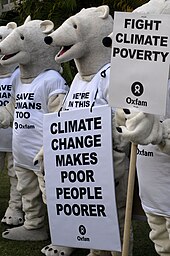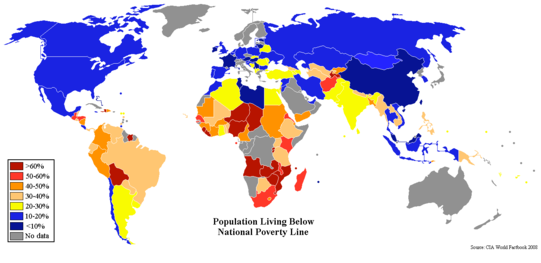
Back تغير المناخ والفقر Arabic Změna klimatu a chudoba Czech 기후변화와 빈곤 Korean Климатските промени и сиромаштијата Macedonian Зміна клімату та бідність Ukrainian 氣候變化與貧困 Chinese

Climate change and poverty are deeply intertwined because climate change disproportionally affects poor people in low-income communities and developing countries around the world. The impoverished have a higher chance of experiencing the ill-effects of climate change due to the increased exposure and vulnerability.[1] Vulnerability represents the degree to which a system is susceptible to, or unable to cope with, adverse effects of climate change including climate variability and extremes.[2]
Climate change highly exacerbates existing inequalities through its effects on health, the economy, and human rights. The Intergovernmental Panel on Climate Change's (IPCC) Fourth National Climate Assessment Report found that low-income individuals and communities are more exposed to environmental hazards and pollution and have a harder time recovering from the impacts of climate change.[3] For example, it takes longer for low-income communities to be rebuilt after natural disasters.[4] According to the United Nations Development Programme, developing countries suffer 99% of the casualties attributable to climate change.[5]
Different countries' impact on climate change also varies based on their stage of development; the 50 least developed countries of the world account for a 1% contribution to the worldwide emissions of greenhouse gasses, which are a byproduct of global warming.[5] Additionally, 92% of accumulated greenhouse gas emissions can be attributed to countries from the Global North, which comprise 19% of the global population, while 8% of emissions are attributed to countries from the Global South, who bear the heaviest consequences of increasing global temperature.[6][7]
Climate and distributive justice questions are central to climate change policy options. Many policy tools can be employed to solve environmental problems such as cost-benefit analysis; however, such tools usually do not deal with such issues because they often ignore questions of just distribution and the environmental effects on human rights.

- ^ Rayner, S. and E.L. Malone (2001). "Climate Change, Poverty, and Intragernerational Equity: The National Level". International Journal of Global Environmental Issues. 1. I (2): 175–202. doi:10.1504/IJGENVI.2001.000977.
- ^ Smit, B, I. Burton, R.J.T. Klein, and R. Street (1999). "The Science of Adaption: A framework for Assessment". Mitigation and Adaptation Strategies for Global Change. 4 (3/4): 199–213. Bibcode:1999MASGC...4..199S. doi:10.1023/A:1009652531101. S2CID 17970320.
{{cite journal}}: CS1 maint: multiple names: authors list (link) - ^ "Fourth National Climate Assessment". Intergovernmental Panel on Climate Change. Archived from the original on 27 October 2019.
- ^ Chappell, Carmin (2018-11-26). "Climate change in the US will hurt poor people the most, according to a bombshell federal report". CNBC. Archived from the original on 31 October 2019. Retrieved 2019-10-31.
- ^ a b "Human Development Report 2007/2008: The 21st Century Climate Challenge" (PDF). United Nations Development Programme. January 2008. Archived (PDF) from the original on April 29, 2011. Retrieved October 23, 2010.
- ^ Hickel, Jason (September 1, 2020). "Quantifying national responsibility for climate breakdown: an equality-based attribution approach for carbon dioxide emissions in excess of the planetary boundary". Archived from the original on December 3, 2020. Retrieved January 4, 2021.
- ^ Hickel, Jason (2020). Less is more: how degrowth will save the world. Penguin Random House. ISBN 978-1785152498. Archived from the original on 2020-12-30. Retrieved 2021-01-04.